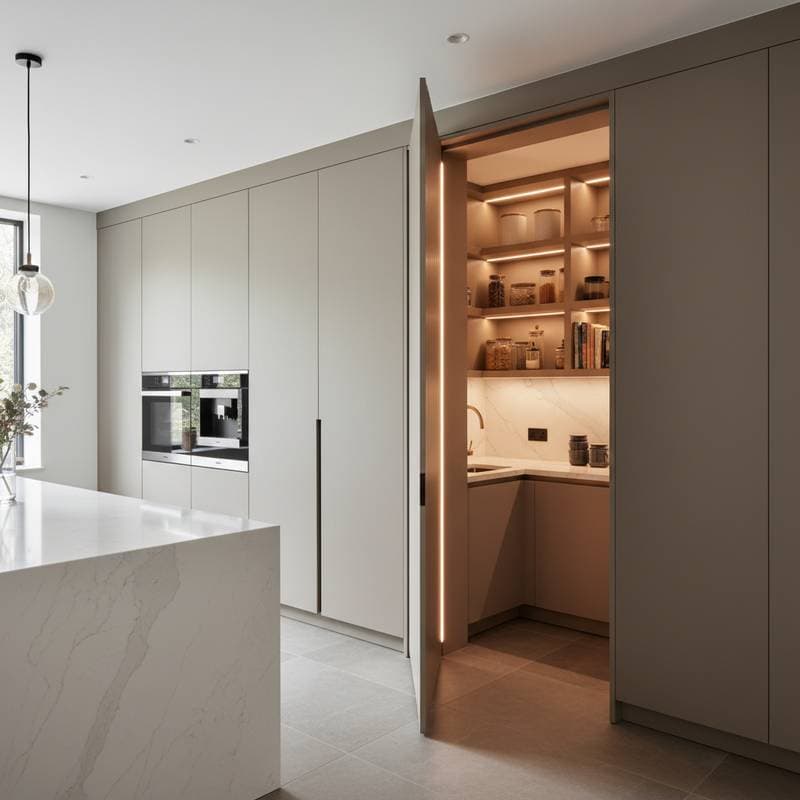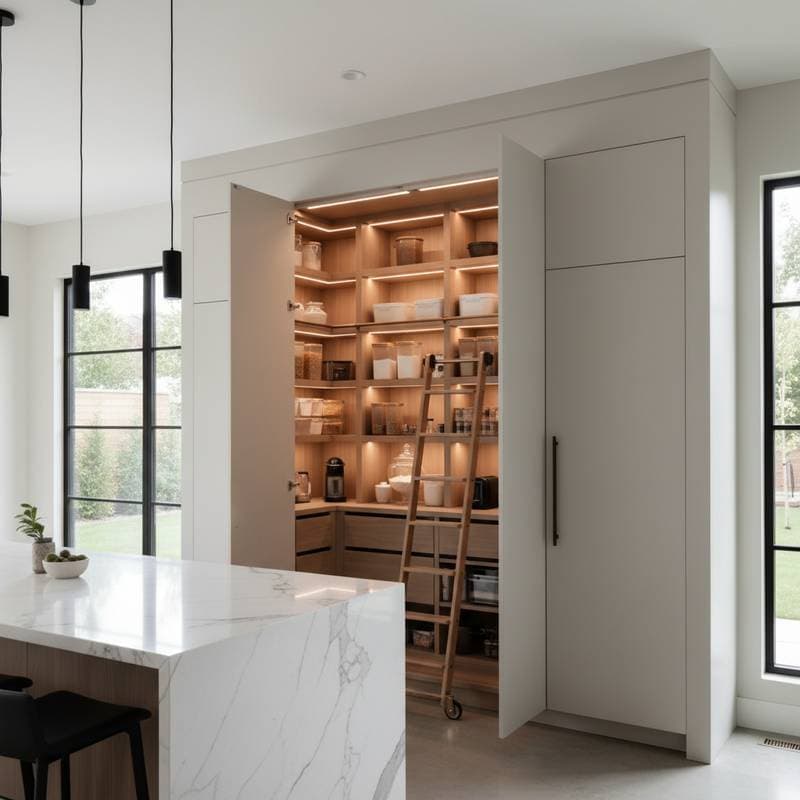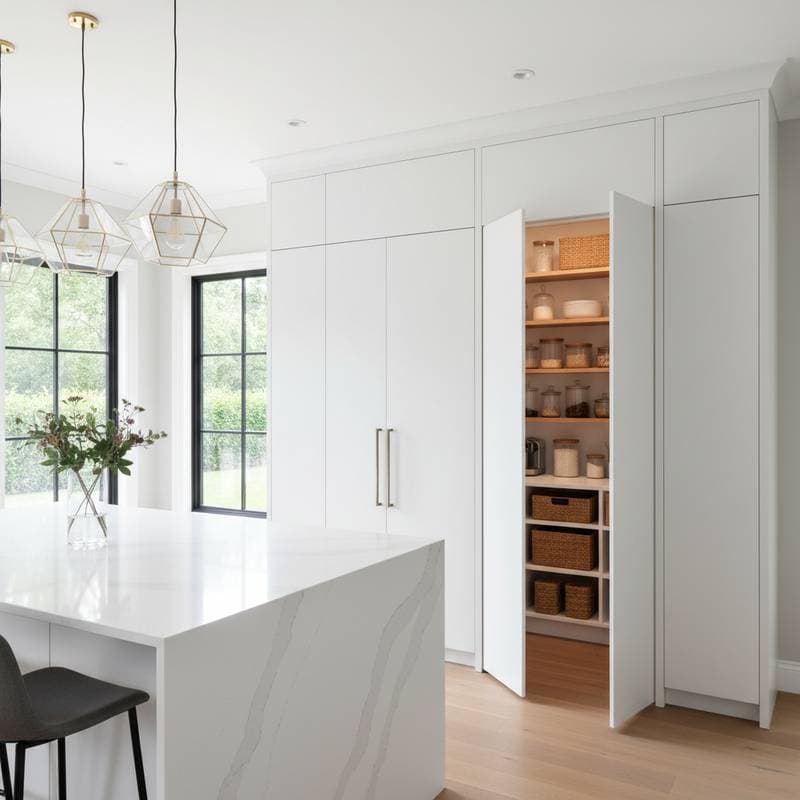Understanding Hidden Pantries and Their Appeal
Hidden pantries represent a sophisticated approach to kitchen organization, concealing storage behind seamless doors or panels that integrate with cabinetry. This design choice maintains a clutter-free appearance while maximizing space efficiency. Homeowners appreciate the added utility, particularly in modern layouts where every square foot counts.
These installations appeal to a wide audience, from families needing ample dry goods storage to design enthusiasts seeking a polished look. The key lies in balancing concealment with accessibility, ensuring the pantry serves daily needs without compromising the kitchen's visual harmony.
Types of Hidden Pantries and Associated Costs
Hidden pantries come in various configurations, each suited to different kitchen styles and budgets. Selection depends on available space, desired level of integration, and overall home aesthetic.
Basic Concealed Closet Conversion
- Cost: $4,500 to $8,000
- Look: Utilizes an existing closet with a flush-mounted door painted to match surrounding walls
- Materials: Standard plywood shelving, basic hinges, and optional pull-out drawers
- Best for: Budget-conscious renovations in traditional homes
Mid-Range: Pocket Door Pantry
- Cost: $8,000 to $12,000
- Look: Sliding door recessed into the wall for a minimalist profile
- Materials: Melamine or laminate cabinetry, soft-close tracks, and integrated shelving systems
- Best for: Compact kitchens requiring space-saving solutions
Premium: Fully Integrated Hidden Room
- Cost: $12,000 to $18,000 or more
- Look: Door seamlessly blends into wall panels or built-in cabinetry with uninterrupted trim lines
- Materials: Solid hardwood cabinetry, premium hardware, dedicated ventilation systems, and custom lighting circuits
- Best for: Open-concept kitchens where design quality significantly influences property value
Important Consideration: Inadequate ventilation can lead to mold growth or food spoilage, especially in humid environments. Always incorporate exhaust fans or dehumidifiers to maintain a safe, dry interior.
Planning Timeline and Cost-Saving Strategies
Projects for hidden pantries typically span 2 to 6 weeks, encompassing design, material procurement, and installation. Delays often stem from extended lead times for custom cabinetry or specialty finishes. To mitigate risks, allocate an additional 3 weeks in the schedule for unforeseen sourcing issues.
Optimal Timing by Season
- Spring and Early Summer: Demand for contractors peaks, resulting in higher labor rates and longer wait times.
- Late Summer to Early Fall: Contractors are more available, and material prices remain steady, offering a favorable window for execution.
- Winter: Reduced activity leads to lower costs, with potential savings of up to 10 percent on interior labor and materials.
Strategies to Control Expenses
- Repurpose Existing Structures: Convert a shallow closet or alcove with minimal structural changes to avoid demolition expenses.
- Opt for Unfinished Cabinetry: Purchase and finish cabinets on-site to reduce costs by $800 to $1,200.
- Select Straightforward Hardware: Avoid complex hidden pivot mechanisms, which increase expenses and complicate adjustments; choose reliable hinges instead.
- Include a Contingency Fund: Reserve 10 to 15 percent of the budget for unexpected issues, such as uneven walls in older properties.
Potential Rebates
Certain locales provide incentives for incorporating energy-efficient elements, such as LED lighting or materials with recycled content. These rebates, though modest, can recover $100 to $200 in finishing expenses.
The Value Proposition of Hidden Pantries
Prospective buyers prioritize kitchens that combine organization with elegant design. A well-executed hidden pantry addresses these preferences by offering concealed storage that enhances perceived space and usability.
Mechanisms Behind the 6 Percent Value Increase:
- Enhanced Visual Appeal: By hiding appliances and supplies, the kitchen appears more spacious and serene.
- Improved Practicality: Custom shelving and zones provide efficient access, eliminating visible clutter.
- Aura of Luxury: Subtle, high-quality craftsmanship conveys thoughtful investment in the home.
- Durability Benefits: Robust construction ensures the feature withstands years of use, minimizing future repair needs.
Real-World Illustration: For a $700,000 property, a complementary hidden pantry could justify a sale price of $740,000 to $745,000, provided it aligns with the kitchen's existing style.
Cautionary Note: Excessive customization in a modest setting may diminish returns. Maintain material and finish consistency throughout the kitchen to safeguard investment value.
Step-by-Step Guide to Installation
Transforming an idea into a functional hidden pantry requires methodical planning. Follow these steps to ensure a smooth process.
- Assess Available Space: Identify underutilized areas, such as dead corners or adjacent closets, and measure dimensions precisely.
- Design the Interior Layout: Determine shelving types, including open racks, pull-out drawers, or dedicated counter spaces for prep work.
- Establish Budget and Schedule: Factor in a 15 percent buffer for variables like material fluctuations.
- Select Concealment Method: Options include cabinet-front doors, sliding panels, or pivoting walls based on space constraints.
- Solicit Professional Quotes: Obtain estimates from at least two specialized carpenters or design-build teams.
- Procure Materials in Advance: Order cabinets and hardware early to circumvent common supply delays.
- Secure Necessary Permits: Submit detailed plans if the project involves structural alterations or electrical additions.
- Coordinate Construction Phases: Align schedules with painters and electricians to minimize kitchen disruption.
- Conduct Thorough Inspection: Verify door alignment, lighting functionality, and overall stability prior to final payment.
Expert Recommendation: Prioritize high-quality lighting as the primary enhancement. Proper illumination reduces food waste and elevates the pantry's premium feel.
Advancing Your Kitchen Upgrade
Hidden pantries merge aesthetic refinement with everyday utility, delivering substantial returns through careful execution. Begin by surveying your kitchen for potential integration sites, such as overlooked nooks. Consult a carpenter experienced in custom cabinetry to obtain an accurate cost assessment.
To optimize resale appeal, emphasize precise craftsmanship and harmonious design elements. A flawlessly aligned door and resilient build will underscore the upgrade's quality more effectively than elaborate detailing.











